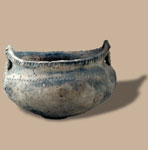|
|
|
The Hirschfelder CollectionThe Victorian age in North America was a period of great public interest in natural history which, at the time, included the study of Aboriginal peoples. Interest in local 'curios' was stirred by the discovery of archaeological sites and artifacts during the clearing of agricultural and industrial lands. Museums began to assemble anthropological collections partly through acquisition of material from private collectors. In 1884, the Geological Survey of Canada acquired a major collection of archaeological specimens from Mr. Charles A. Hirschfelder, an amateur archaeologist from Toronto. He published and lectured on Ontario archaeology in the 1880s and also promoted the idea of a national archaeological museum. This acquisition included a wide range of artifact types spanning 10,000 years of pre-contact and contact history in Ontario and Quebec and formed a cornerstone collection for the Survey's newly emerging Department of Anthropology in 1910. Now part of the archaeology collections of the Canadian Museum of Civilization, the Hirschfelder collection numbers about 2300 specimens, a portion of which is presented here, including ceramic pipes, tools such as adzes for woodworking, stone arrow and spear points for hunting. |
Bibliography · Links · Credits · Index


